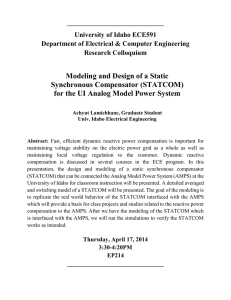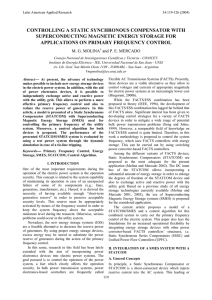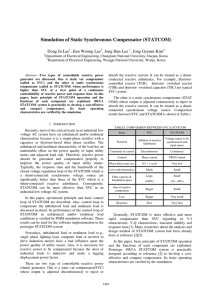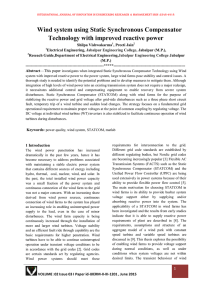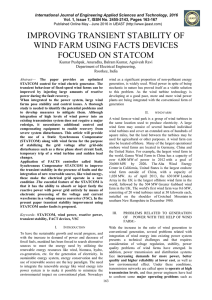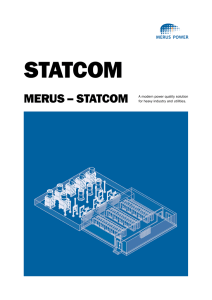ELG4125: Flexible AC Transmission Systems (FACTS)
advertisement
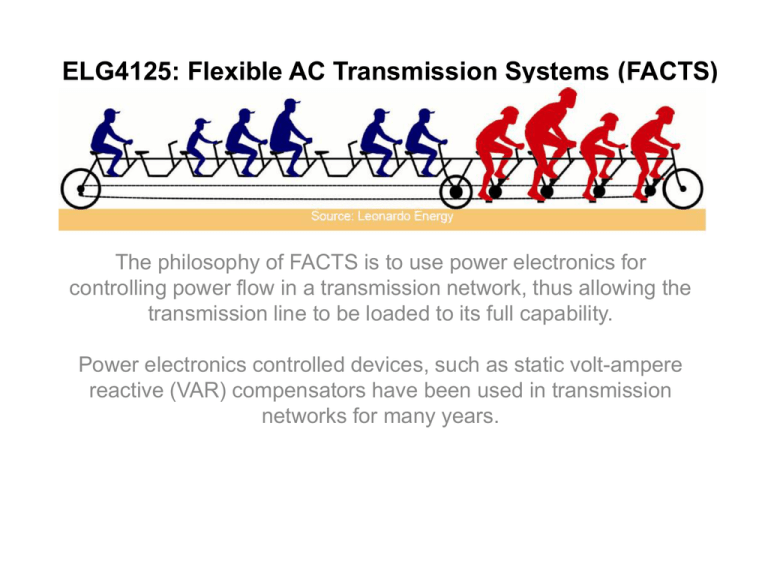
ELG4125: Flexible AC Transmission Systems (FACTS) The philosophy of FACTS is to use power electronics for controlling power flow in a transmission network, thus allowing the transmission line to be loaded to its full capability. Power electronics controlled devices, such as static volt-ampere reactive (VAR) compensators have been used in transmission networks for many years. Flexible AC Transmission System (FACTS) is an integrated concept based on power electronic switching converters and dynamic controllers to enhance the system utilization and power transfer capacity as well as the stability, security, reliability and power quality of AC system interconnections. FACTS is a collection of thyristor-based controllers, including phase shifters, advanced static VAR compensator, dynamic brake, modulator series capacitor, load tap changer, fault current limiter, and perhaps other that have yet to be invented. In recent years, energy, environment, right-of-way, and cost problems delayed the construction of both generation facilities and new transmission lines. This has necessitated a change in the traditional power system concepts and practices; better utilization of existing power systems has become imperative. Objectives of FACTS • Control power so that it flows on the desired routes. Power may be controlled by applying a voltage in the midpoint or by applying a voltage in series with the line and in phase quadrature with the current flow or by regulating the magnitude of sending and receiving end voltages (This is more effective than the previous techniques) • Increase loading capacity of transmission lines. • Prevent blackouts. • Improve generation productivity. Varying the line impedance X and the voltage difference may Control the power flow in a Transmission line. What Limits the Loading Capability? Thermal For overhead line, thermal capability is a function of ambient temperature, wind conditions, conditions of conductor, and ground clearance. The FACTS technology can help in making an effective used of newfound line capability. Dielectric Being designed very conservatively, most lines can increase operation voltage by 10% or even higher. FACTS technology could be used to ensure acceptable over-voltage and power flow conditions. Stability The stability issues that limit the transmission capability include: transient stability, dynamic stability, steady-state stability, frequency collapse. Voltage collapse, and sub-synchronous resonance. The FACTS technology can certainly be used to overcome any of the stability limits. Power Factor Correction Most loads on an electrical distribution system fall into one of three categories; resistive, inductive or capacitive. In most plant, the most common is likely to be inductive. Typical examples of this include transformers, fluorescent lighting and AC induction motors. Most inductive loads use a conductive coil winding to produce an electromagnetic field, allowing the motor to function. All inductive loads require two kinds of power to operate: Active power (KW) - to produce the motive force; Reactive power (KVAR) - to energize the magnetic field The operating power from the distribution system is composed of both active working) and reactive (non-working) elements. The active power does useful work in driving the motor whereas the reactive power only provides the magnetic field. 6 Power Factor Correction The amount of Power Capacitor KVAR required to correct A system to a desired Power Factor level is the difference between the amount of KVAR in the uncorrected system and the amount of desired KVAR in the corrected system. The most efficient location for power factor capacitors is at the load. Capacitors work from the point of installation back to the generating source. Individual motor correction is not always practical, sometimes it is more practical to connect larger capacitors on the distribution bus or install an automatic system at the incoming service along with fixed capacitors at the load. 7 Power Factor Correction Techniques • • • Static VAR Compensator(SVC) • Fixed Capcitors • Switch Capacitors • Synchronous Condensors Static Synchronous Compensator(STATCOM) Modulated power filter capacitor compensator 8 Fixed Capacitor Where the load does not change or where the capacitor is switched with the load, such as the load side of a Ideally suited for power factor correction in applications motor contactor. It is suitable for locations using induction motors, like food processing plants, or where small multiple loads require reactive power compensation. Each Fixed Capacitor Bank is designed for high reliability and long life. These products are designed for applications that do not contain harmonic generating 9 Switched Capacitor It is suited for centralized power factor correction in applications where plant loading is constantly changing, resulting in the need for varying amounts of reactive power. An advanced microprocessor-based reactive power controller measures plant power factor via a single remote current transformer (included), and switches capacitor modules in and out of service to maintain a user-selected target power factor. Typically applied at service entrance or near fluctuating loads. 10 Synchronous Condenser Synchronous condenser is a salient pole synchronous generator without prime mover. Synchronous condenser stabilizes power system voltage by supplying reactive power to the power system and use for power factor correction. It is more economical than capacitors. 11 Static VAR Compensator (SVC) The Static VAR Compensator (SVC) is a shunt device of the Flexible AC Transmission Systems (FACTS) family using power electronics to control power flow and improve transient stability on power grids. The SVC regulates voltage at its terminals by controlling the amount of reactive power injected into or absorbed from the power system. When system voltage is low, the SVC generates reactive power (SVC capacitive). When system voltage is high, it absorbs reactive power (The variation of reactive power is performed by switching three-phase capacitor banks and inductor banks connected on the secondary side of a coupling transformer. Each capacitor bank is switched on and off by three thyristor switches (Thyristor Switched Capacitor or TSC). Reactors are either switched on-off (Thyristor Switched Reactor or TSR) or phase-controlled (Thyristor Controlled Reactor or TCR). 12 Static VAR Compensator (SVC) Static Synchronous Compensator (STATCOM) The Static Synchronous Compensator (STATCOM) is a shunt device of the Flexible AC Transmission Systems (FACTS) family using power electronics to control power flow and improve transient stability on power grids. The STATCOM regulates voltage at its terminal by controlling the amount of reactive power injected into or absorbed from the power system. When system voltage is low, the STATCOM generates reactive power (STATCOM capacitive). When system voltage is high, it absorbs reactive power (STATCOM inductive).Similarly to the SVC the STATCOM can provide instantaneous and continuously variable reactive power in response to grid voltage transients enhancing the grid voltage stability 14 STATIC SYNCHRONOUS COMPENSTOR (STATCOM) The Static Synchronous Compensator (STATCOM) is a shunt device of the Flexible AC Transmission Systems (FACTS) family using power electronics to control power flow and improve transient stability on power grids. The STATCOM regulates voltage at its terminal by controlling the amount of reactive power injected into or absorbed from the power system. When system voltage is low, the STATCOM generates reactive power (STATCOM capacitive). STATCOM is GTO or IGBT based! 15 Basic types of FACTS Controllers Series Controllers The series controller could be a variable impedance or a variable source both are power electronics based. In principle, all series controllers inject voltage in series with the line. Shunt Controllers The shunt controllers may be variable impedance connected to the line voltage causes a variable current flow hence represents injection of current into the line. Combined Series-series Controllers The combination could be separate series controllers or unified series-series controller-Interline Power Flow Controller. Combined Series-shunt Controllers The combination could be separated series and shunt controllers or a unified power flow controller Shunt Connected Controllers Series Connected Controllers Combined Shunt and Series Connected Controllers FACTS Key Devices • Static Synchronous Compensator (STATCOM). • Static Synchronous Series Compensator (SSSC). • Unified Power Flow Controller (UPFC). STATCOM Static Compensator: Advanced Static VAR Compensator (Shunt Connected Controller) Main features: Wide operating range; Lower rating than SVC; Increased transient rating and superior capability to handle dynamic system disturbances. It is a device connected in derivation, basically composed of a coupling transformer, that serves of link between the electrical power system and the voltage synchronous controller (VSC), that generates the voltage wave comparing it to the one of the electric system to realize the exchange of reactive power. The control system of the STATCOM adjusts at each moment the inverse voltage so that the current injected In the network is in quadrature to the network voltage, in these conditions P = 0 and Q = 0. STATCOM Model and Equivalent Circuit
